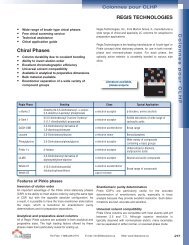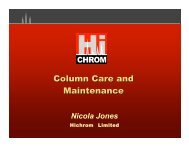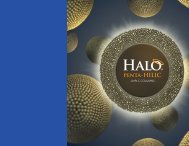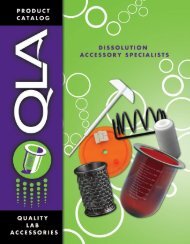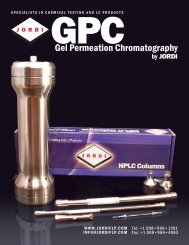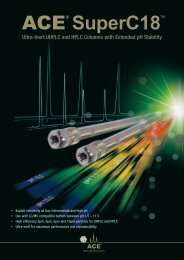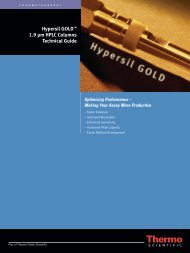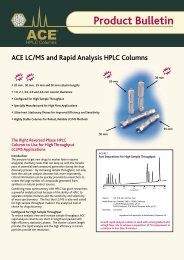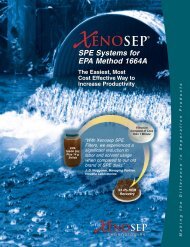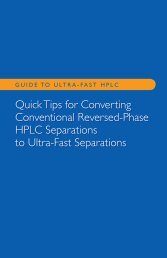Download Entire Catalog - Regis Technologies
Download Entire Catalog - Regis Technologies
Download Entire Catalog - Regis Technologies
You also want an ePaper? Increase the reach of your titles
YUMPU automatically turns print PDFs into web optimized ePapers that Google loves.
Ultrapure Ion Pairing Reagents and Buffers<br />
Ion Pair Chromatography is a method<br />
for improving the separation of charged<br />
analytes. In the resolution of organic ions<br />
with conventional HPLC methods, use<br />
of ion pair reagents can enhance peak<br />
shape and retention time when common<br />
remedies such as modifying eluent ratios<br />
or changing stationary phase fail.<br />
The Advantages of Ion Pair Chromatography<br />
In the past, chromatographic separation of charged analytes has been<br />
achieved by ion suppression (the careful adjustment of the mobile<br />
phase pH to result in a nonionized analyte). Determining the optimum<br />
mobile phase pH in ion suppression, however, often requires extensive<br />
method development. Samples containing more than one ionizable<br />
component were often unusable. The imitations of ion suppression led<br />
to the development of a new, more generally applicable approach to<br />
separation of ionized components: ion pair chromatography.<br />
Developed by Dr. Gordon Schill in 1973, ion pair chromatography<br />
relies upon the addition of ionic compounds to the mobile phase to<br />
promote the formation of ion pairs with charged analytes. These<br />
reagents are comprised of an alkyl chain with an ionizable terminus<br />
(figure 1). When used with common hydrophobic HPLC phases in the<br />
reversed-phase mode, ion pair reagents can be used to selectively<br />
increase the retention of charged analytes (figure 2).<br />
Although ion exchange chromatography has become a popular mode<br />
of separation, it is not useful in all situations. The advantages of ion<br />
pair chromatography over ion exchange chromatography are:<br />
• Simple preparation of buffers<br />
• Wide choice of carbon chain lengths for improved retention<br />
and separation<br />
• Significantly reduced separation time<br />
• Simultaneous separation of both ionized and nonionized solutes<br />
• Highly reproducible results<br />
• Improved peak shape<br />
Figure 1. Quaternary Amine (Q-Series) Ion<br />
Pair Reagent.<br />
<strong>Regis</strong> Provides a Choice of Reagents<br />
<strong>Regis</strong> manufactures both ultrapure anionic Sulfonate (S-Series) and<br />
cationic Quaternary Amine (Q-Series) ion pair concentrates in the<br />
following alkyl chain lengths: pentyl, hexyl, heptyl, octyl, and dodecyl.<br />
Alkyl chains are represented by cardinal numbers in the naming of<br />
our products, i.e., 5, 6, 7, 8, and 12. (See product descriptions on the<br />
following pages.)<br />
Figure 2. Quaternary Amine (Q-Series) Ion<br />
Pair Reagent interacting with C-18 Support.<br />
36<br />
For more information visit www.registech.com/ionpair



